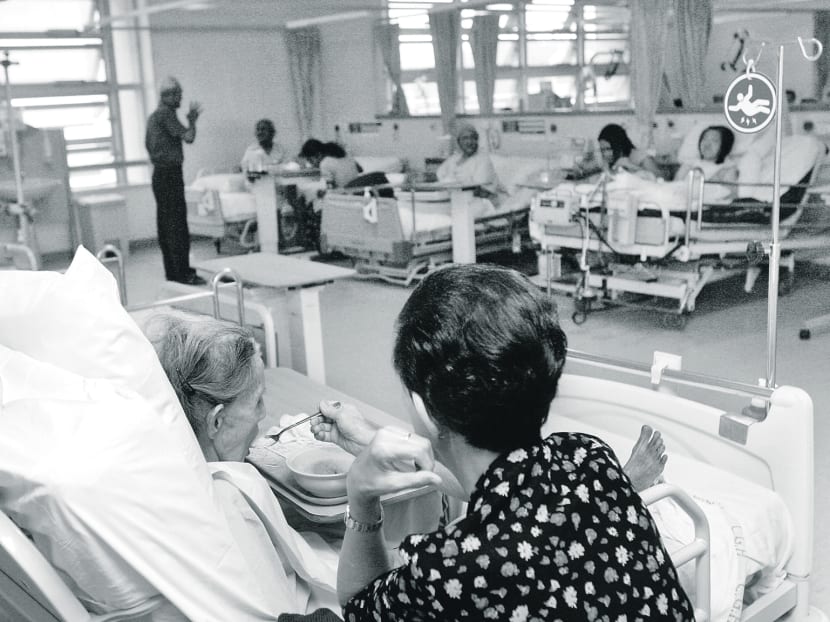Synching healthcare for an ageing population
Singapore’s population is ageing rapidly and the repercussions are being felt across the country. Nowhere is this more evident than in the healthcare system, where policymakers have to make decisions about hospitals, social services and manpower for which the benefits may not be seen for several years.

Increasing the number of acute care hospital beds is not sufficient to address the healthcare needs of Singapore; we must also address factors that influence the flows in and the flows out of hospitals. TODAY file photo
Singapore’s population is ageing rapidly and the repercussions are being felt across the country. Nowhere is this more evident than in the healthcare system, where policymakers have to make decisions about hospitals, social services and manpower for which the benefits may not be seen for several years.
Keeping the system in sync as we build up healthcare capacity to respond to growing needs is a challenge of heroic proportions.
As an illustration of the challenge: When a new acute care hospital opened recently, it was noted that instead of alleviating the hospital bed crunch, the hospital immediately filled up and waiting times in the A&E seemed just as onerous. Intuition seemed to suggest that new capacity should visibly alleviate some of the pressure. Why wasn’t there prolonged relief?
One explanation is that the capacity of one more hospital was still not sufficient to accommodate demand for hospital admissions, and the relief — such as it was — lasted only as long as it took for the new hospital to fill it up. Like a bathtub filling faster than it is emptying, increasing the size of the bathtub provides only a temporary measure.
The crucial question for Singapore policymakers is not simply how many hospitals to build, but how to decrease inflow and increase outflow so that we do not need as many hospitals.
CARE IN THE COMMUNITY
Hospitals are wonderful for what they are especially good at: Urgent, high-intensity and specialty services.
But they are also expensive and hospital stays can be burdensome to patient and families, and are associated with risk, such as hospital-acquired infection.
In responding to this question of how to decrease inflow to and increase outflow from hospitals, Singapore is turning to innovations in outpatient and social care services. The case for this refocus from a historical preference for acute hospitals is compelling.
Effective outpatient services can alleviate the burden on hospitals through prevention of major illnesses: For example, high blood pressure is a risk for stroke and treatment of high blood pressure can cut that risk in half among older individuals. Yet, two out of four Singaporeans over 60 years of age have high blood pressure. Of this group, two out of three are treated.
However, among those treated, two in three do not have their blood pressure under control. Outpatient services can provide an effective alternative to individuals traditionally cared for in hospitals.
For example, evidence from international studies as well as efforts in Singapore indicate that many hospitalisations for heart failure — a common cause of recurrent admission — can be managed in the community at comparable quality and lower cost.
Regarding community and social care, improved access to affordable and attractive transitional and long-term care can potentially reduce length of stay by breaking “bed lock” — the lack of a place to discharge a patient when he has received the appropriate acute care.
Several hundred people island-wide are likely in this situation, especially elderly, disabled patients, who are an increasing fraction of all patients admitted to hospital. Further, people living alone or otherwise in unstable social situations presenting to A&E are more likely to be readmitted largely because doctors in the A&E do not have an alternative.
FLOWS IN, FLOWS OUT
The upshot of all this is that increasing the number of acute care hospital beds is not sufficient to address the healthcare needs of Singapore; we must also address the factors that influence the flows in and the flows out of our hospitals — in other words, we have to get in sync.
This means raising the capabilities of outpatient health services to accommodate the needs of an ageing population so fewer need hospitalisation, and increasing available long-term care services so people who no longer need acute hospital services can be discharged to more appropriate sites and avoid readmission.
This is, indeed, the strategy being pursued by Singapore: More clinic availability (including creating new service options such as community-based care), more long-term care options (such as home services, better trained maids and more nursing home beds), and more community hospitals to allow patients to achieve a level of health and independence that may permit them to live at home with family.
Our research group at Duke-NUS, and others across the country, are studying the impact of these strategies, both in computer simulation studies and in real-world trials.
Healthcare is a complex system with many parts. We must keep our eyes on the whole system, and especially how our actions effect flows in and out of all these parts, if we are to avoid becoming an island of overflowing bathtubs.
ABOUT THE AUTHOR:
David Matchar is Professor and Director, Program in Health Services and Systems Research at the Duke-NUS Graduate Medical School Singapore.






